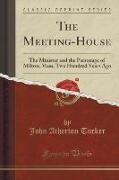- Start
- The Meeting-House
The Meeting-House
Angebote / Angebote:
Excerpt from The Meeting-House: The Minister and the Parsonage of Milton, Mass, Two Hundred Years Ago
In the Colonial days it had been a custom almost universal for the Town to build the meeting house and care for the running expenses of public worship, meeting the cost by taxation as one of the ordinary outlays of the Town. This method prevailed till within something like one hundred years, when denominations with other beliefs than that of the early settlers coming in it was found more equitable for each sect to maintain its peculiar faith at its own expense.
Before this change of method took place, the Town of Milton on four different occasions had the experience of selecting a location for a place of worship and erecting a building suitable for that purpose. Milton's first meeting house appears to have been built about the middle of the seventeenth century, while our Town was still a part of Dorchester, and the name of Milton had not as yet been given to this part of the parent Town south the Neponset The site of this place of worship is said to have been at the junction of Adams Street and Churchill's Lane, and this view would seem to account for the unusual wide opening of the lane as it enters the main street. This opening, according to the "History of Milton." page 192, "at that date was larger than now."
The green triangle as at present laid out at this spot would admit of a building 30 by 35 feet, which is three times the size of the first meeting house in Salem built in 1634.
But whatever its size, and whenever or wherever built, this first public building in Milton served as a place of weekly devotion for the early settlers here, and also for some of those from the nearer parts of Braintree, which was our next neighbor on the southeast. The Town having thus provided a place of worship, next turned their attention to the securing a home for whoever might serve them in the ministry.
At that time and previous to the coming of Mr. Thacher, the minister was hired by the year and his stay being uncertain he would not care to buy land and build a house till better assured of remaining. Probably at this time nearly every house in town was occupied by the owner thereof. The custom of adorning the front yard or window pane with the sign "To Let" had not as yet been introduced, and the means of conveyance was so scant that it was desirable for the minister to live near the meeting house.
So the Fathers feeling the want of a parsonage joined together and secured a tract of eight acres which would give room not only for a dwelling and door yard but also a garden, orchard, pasturage, etc., these being necessary in con. nection with the scanty salary then paid, for the Parson to eke out a living for himself and his growing family.
The Town came in possession of this "Ministerial lot, " as it is called, Jan. 30, 1662, and previous to July, 1664. had built the parsonage. From that time to 1680 the Town had fora shorter or a longer term four and perhaps five different men to serve them in the ministry. Some of these occupied the parsonage. Mr. Emerson was here two years or more, from 1666 to 1669.
Next came Mr. Wiswell who is mentioned in the "History of Milton" as follows: "In Feb., 1669, a committee was sent to Sandwich to treat with Mr. Wiswell to be helpfull with us in the ministry, offering him 60 per year and the use of house and lands and liberty to cut wood for his own use." This "house and lands" was the parsonage and the ministerial land already mentioned.
About the Publisher
Forgotten Books publishes hundreds of thousands of rare and classic books. Find more at www.forgottenbooks.com
Folgt in ca. 5 Arbeitstagen
